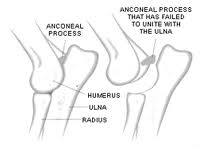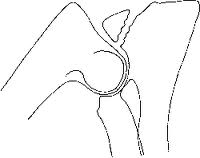


Working together with the
KENNEL CLUB
for a better future
KENNEL CLUB
for a better future
Elbow Dysplasia
Elbow Dysplasia - ED simply means abnormal development of the elbow . The term includes a number of different specific abnormalities that affect different sites within the joint. These can cause problems by affecting the growth of the cartilage which forms the surface of the joint or the structures around it.
These abnormalities are primary lesions which then induce a secondary osteoarthritic process. The most common lesions are:
OSTEOCHODRITIS DISSECANS (OCD or OD)
FRAGMENTED OR UNUNITED MEDIAL CORONOID PROCESS (FCP)
UNUNITED ANCONDREAL PROCESS (UAP)
Primary lesions begin early, during the growth of a puppy, and are commonly present in both elbows to some extent. When the dog reaches skeletal maturity the primary lesions may stabilise as abnormal, needing no surgical intervention.
The elbow is particularly vulnerable to this type of disease. The joint resembles a hinge in which the bones and cartilage forming each side of the joint have complex shapes that fit together closely. The elbow has a whole range of joint movement. Thus, a small change in the shape of one part of the joint can have major consequences for the joint function. Once elbow function is affected, foreleg gait (movement) becomes altered.
Causes of elbow dysplasia
ED is a multifactorial disease, which means that a number of factors can influence the occurrence of the condition. The most important factor, however, is the genetic make up of the dog. Other factor such as growth rate, diet, and level of exercise may influence the severity of the disease in an individual dog. Studies have shown that ED has a high heritability confirming that a high proportion of the disease is genetic.
Should you be told your Basset Hound needs to be rested or its movement restricted and you don't know what you need or what you should do, don't worry
all you need to know is here
These abnormalities are primary lesions which then induce a secondary osteoarthritic process. The most common lesions are:
OSTEOCHODRITIS DISSECANS (OCD or OD)
FRAGMENTED OR UNUNITED MEDIAL CORONOID PROCESS (FCP)
UNUNITED ANCONDREAL PROCESS (UAP)
Primary lesions begin early, during the growth of a puppy, and are commonly present in both elbows to some extent. When the dog reaches skeletal maturity the primary lesions may stabilise as abnormal, needing no surgical intervention.
The elbow is particularly vulnerable to this type of disease. The joint resembles a hinge in which the bones and cartilage forming each side of the joint have complex shapes that fit together closely. The elbow has a whole range of joint movement. Thus, a small change in the shape of one part of the joint can have major consequences for the joint function. Once elbow function is affected, foreleg gait (movement) becomes altered.
Causes of elbow dysplasia
ED is a multifactorial disease, which means that a number of factors can influence the occurrence of the condition. The most important factor, however, is the genetic make up of the dog. Other factor such as growth rate, diet, and level of exercise may influence the severity of the disease in an individual dog. Studies have shown that ED has a high heritability confirming that a high proportion of the disease is genetic.
Should you be told your Basset Hound needs to be rested or its movement restricted and you don't know what you need or what you should do, don't worry
all you need to know is here
Dogs with ED may or may not be lame, therefore, using lameness to determine its presence or the breed worthiness of an animal is foolhardy. Dogs with clinical ED typically develop foreleg lameness between the ages of 5-12 months of age, however, in some cases the lameness may not be apparent until as late as 5-7 years of age.
The lameness may be variable and periodic. Some dogs may demonstrate soreness after rest, improve slightly with activity, but then worsen with increased activity. There may be intervals with no lameness at all. Jumping and sharp fast turns usually exaggerate the lameness.
Pain can be elicited by overextending the elbow, and there may be a slight to moderate swelling noticeable when carefully feeling the elbow joint. If both legs are meaningfully affected the lameness may be more difficult to detect. Careful observation would show slight rotation of the top of the leg outwardly, as well as a stiff or stilted movement of the forelegs. There may be a reluctance on the dogs part to land hard on the front legs (e.g. trotting, loping or landing jumps).
If your Basset develops lameness and is diagnosed with an "elbow problem", discuss with your vet the possibility of Panosteitis. Please click on the link for more information
The lameness may be variable and periodic. Some dogs may demonstrate soreness after rest, improve slightly with activity, but then worsen with increased activity. There may be intervals with no lameness at all. Jumping and sharp fast turns usually exaggerate the lameness.
Pain can be elicited by overextending the elbow, and there may be a slight to moderate swelling noticeable when carefully feeling the elbow joint. If both legs are meaningfully affected the lameness may be more difficult to detect. Careful observation would show slight rotation of the top of the leg outwardly, as well as a stiff or stilted movement of the forelegs. There may be a reluctance on the dogs part to land hard on the front legs (e.g. trotting, loping or landing jumps).
If your Basset develops lameness and is diagnosed with an "elbow problem", discuss with your vet the possibility of Panosteitis. Please click on the link for more information







Official site of the Basset Hound Health Group
The Basset Hound Health Group - is run under the auspices of all 8 UK based Basset Hound Breed Clubs
The Basset Hound Health Group - is run under the auspices of all 8 UK based Basset Hound Breed Clubs